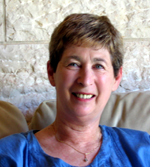By Dorothea Shefer-Vanson

MEVASSERET ZION, Israel -In preparation for our summer in France, or perhaps simply because I like to think I can read books in French, I bought Anne Sinclair’s book, 21 Rue la Boetie. Reading it took me into the fascinating world of French art in the twentieth century, with extensive ramifications regarding the Holocaust, the way the French colluded with the Germans in stealing works of art from Jews, and the efforts of the French Resistance to confound this. Having just finished reading the book, I feel I want to share what I have learned with others who may have similar interests.
By now everyone knows Anne Sinclair as the longsuffering wife of former IMF president, Dominique Strauss-Kahn, who may or may not have done some naughty things with various women. But Anne Sinclair is a well-known journalist, television personality and writer in her own right, as well as being a very beautiful woman. In addition, she writes well and the tale she tells is well worth reading.
As she states in the preface to the book, which was published this year (2012), the trigger that set off her research into the background of her family, and specifically the history of her maternal grandparents, was what happened one day when a Parisian policeman stopped her in her car and asked her for her driving license. As she had just moved house she didn’t have it on her, and was told to report with the document next day to the nearest offices of the Ministry of the Interior. Upon presenting herself there, she was shocked to be asked by an official: “Were all four of your grandparents born in France?”
Conscious of her Jewish roots, Anne replied that it was that kind of question that was asked before people were packed into cattle trucks and sent off to concentration camps seventy years earlier. The official didn’t seem to understand, and that caused Anne to embark on many months of research in museums, official and family archives, to ascertain her family history.
All of Anne’s grandparents were Jewish. Her maternal grandfather, Paul Rosenberg, was born in Poland in 1881 and came to France with his family as a child. His father was a wine merchant, but both he and his brother, Leonce, were art dealers. By touring the museums of Europe as a young man, Paul developed a good understanding of art, and used this to discover and befriend many young artists, among them Picasso, Braque and Matisse. He fostered their careers and dealt in their art, using his gallery at 21 rue la Boetie for this purpose. The building was an impressive one, with apartments for the family above the spacious ground floor, where exhibitions were held.
Paul Rosenberg was an almost exact contemporary of Picasso, and the two became great friends, referring to one another as ‘Rosi’ and ‘Pic’ in their correspondence. For some time Picasso lived next door to the Rosenbergs, when he was newly married to Olga, a dancer at Diaghilev’s ‘Ballets Russes.’ Anne Sinclair’s book contains photos of Picasso’s pictures of her grandfather and her mother, as well as a photograph of herself as a teenager with the artist. When she was a child Picasso offered to paint her, too, but she ojected to the idea, so the picture never came into existence.
In 1940, when the Germans invaded France, the Rosenberg family took refuge first in the South of France, then in Portugal, eventually managing to get to the USA, where Anne herself was born in 1943. Paul Rosenberg was forced to abandon his business in Paris and all the paintings he had acquired. These included many by leading Impressionists, as well as a large number by Picasso, Braque and Matisse. He had, however, managed to send a fair number of canvases to the USA beforehand, and so was able to open a gallery in New York.
Anne Sinclair describes in hair-raising detail how the Germans established their office for administering Jewish affairs in the building that had previously housed her grandfather’s art gallery, and how, aided and abetted by the French people who had been employed by the family, they systematically plundered all the art works, furniture, sculptures and objects that had adorned the premises. But as Paul Rosenberg himself said after the war, when the murderous criminality of the Nazis became common knowledge, the loss of his property was as nothing compared with the horrors the Nazis had inflicted on people of all nations, and especially on the Jews.
After the war Paul Rosenberg devoted considerable time and effort to tracing his plundered property and getting it restored to him. Many items had found their way into private hands and museums in various European countries, and although it was not always easy to get them to return the stolen property, on the whole he was successful in his quest. Many of the people concerned, especially those who had been employed by the family, were brought to trial and forced to confess their deeds. Anne makes no bones about mentioning them by name and calling them ‘miserable little thieves.’
In a sad little epilogue Anne mentions that she has recently had occasion to return to her beloved New York under tragic circumstances. Let’s hope that the peccadilloes of her husband, from whom she is now separated, will not overshadow the impact of her interesting and well-written book. I hope for the sake of all those who do not read French that the book has been, or soon will be, translated into English.
*
Shefer-Vanson is a freelance writer based in Mevasseret Zion, Israel. She may be contacted at dorothea.shefer@sdjewishworld.com